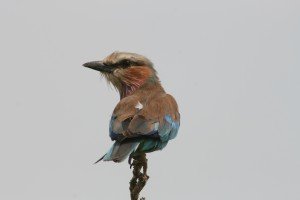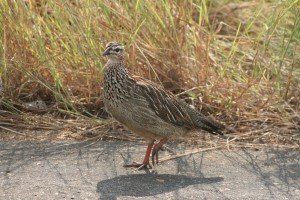Letaba to Punda Maria 0
Driving the 177km from Letaba to Punda Maria in a day is a real test of endurance. The far north of Kruger National Park is often incredibly hot in summer and flat mopaneveld stretches on for miles and miles, with birds few and far between.
Generally the birdlife is concentrated along the alluvial floodplains which are well-wooded, especially in the Shingwedzi region, and the mixed woodland on shale, particularly around Punda Maria.
And so it becomes very important to focus as soon as you hit an area that looks promising for birds because, after an hour on the tar road driving through stunted Mopane grassland, you don’t want to miss the sightings that do suddenly materialise.
March 9 was a case in point. Approaching Mopani camp in the middle of the day with the temperature reading 39°, my mind was definitely straying towards the ice-cold Coke I was so lusting for as I neared the turnoff to one of the newer Kruger Park camps.
The Shipandani stream crosses that turnoff, temporarily running parallel to the H1-6, and late summer rains meant there was a fair bit of water pooled up against the culvert. With long grass on the banks and an overhanging tree, it looked a likely spot for something interesting, so I stopped to scan the area carefully, thoughts of much-needed refreshment being put to the side.
And I’m glad I did. Amidst the other more common birds hanging around, I noticed the unmistakable blue flash of a kingfisher …
There being water around, my initial thought was obviously a Malachite, but this kingfisher was too big as it returned to its perch, a dead stick on the edge of the pool. How about a Halfcollared Kingfisher, which I had never seen before in Kruger Park, but which has been uncommonly recorded … ?
But the head was not blue, but a dirty whitish-grey in colour, and then I saw the chestnut belly and so it could only be the even scarcer Greyheaded Kingfisher, only my second sighting of this beautiful bird.
On such a sweltering day, it was unsurprising that this African migrant was bathing and preening. Suitably inspired, I was soon refreshing myself at Mopani camp before pressing on for Punda Maria.
With the waterholes full, there were sporadic patches of exciting bird activity: An excellent patch of flooded grassland around the N’warihlangari waterhole, 20km north-west of Shingwedzi, provided Orangebreasted Waxbill, a very rare bird in Kruger and a special sighting, just my third anywhere.
Eurasian Golden Oriole was spotted dashing along the tree-lined Nkokodzi River heading towards Shingwedzi, a Tawny Eagle was hanging around Bowkerkop and a Striped Cuckoo was calling and moving along the Tsendze River, providing an exciting close-up sighting at the Mooiplaas picnic site just outside Mopani.
The long day began at Letaba camp, which is an excellent birding spot in its own right because it is on the sizeable Letaba River and the woodland is full of well-established trees.
Blackbacked Puffback, Paradise Flycatcher, Yellowbreasted Apalis, Dusky Flycatcher and Redwinged Starling were all seen while packing up camp, while friendly Bushbuck, Tree Squirrels and Dwarf Mongoose also came by.
Driving north out of Letaba along the H1-6, there are several kilometres of river frontage to enjoy and I was able to add Little and Whitefronted Bee-Eaters, Emeraldspotted Wood Dove, Nile Crocodile, Goliath Heron, Black Stork, African Spoonbill and Yellowbilled Kite to the growing list.
As you cross the Tropic of Capricorn, 16km north-west of Mopani, the S144 turnoff to the north-east takes you into dry Mopane scrubveld. Having seen them before in this exact area, I was thinking Redcrested Korhaan could well be the next bird to tick off and hey presto! one male started his distinctive clicking call and was then found sheltering under a bush.
The beautiful Shingwedzi camp was unfortunately closed due to most of it being washed away in the previous floods (which is why my need for a Coke was so great at Mopani!), but a Southern Black Tit was picked up at the turnoff.
The open veld north of Shingwedzi has rank grasslands growing and this is perfect habitat for the Whitewinged Widow. Even better habitat was found the following day, 3.5km north of the S59 near Punda Maria, with hundreds roosting in the long grass there.
The wonderful thing about birding in Kruger Park is, of course, the incredible variety of birds that are drawn to the bushveld. The famous reserve is the centre of activity for more than 500 bird species.
And so, just before the tropical lushness of the N’warihlangari waterhole, one drives through an area of dry, stunted savanna grasssland, overgrazed as summer gives way to autumn, and Chestnutbacked Sparrowlark, a fairly uncommon bird to look out for in the eastern half of the park, made an appearance.
Sightings list
Brownbacked Tree Frog
Blackbacked Puffback
Bushbuck
Blackeyed Bulbul
Paradise Flycatcher
Tree Squirrel
Yellowbreasted Apalis
Impala
Little Swift
Dusky Flycatcher
Redwinged Starling
Dwarf Mongoose
Lappetfaced Vulture
Little Bee-Eater
Emeraldspotted Wood Dove
European Swallow
Blue Waxbill
Common Sandpiper
Nile Crocodile
Greenshank
Goliath Heron
Wiretailed Swallow
Whitefronted Bee-Eater
Hippopotamus
Wood Sandpiper
Blacksmith Plover
Egyptian Goose
Threebanded Plover
Black Stork
Redfaced Cisticola
Pied Kingfisher
African Spoonbill
Grey Heron
Yellowbilled Kite
Namaqua Dove
Striped Cuckoo
Southern Black Flycatcher
Cinnamonbreasted Rock Bunting
Carmine Bee-Eater
Blue Wildebeest
Swainson’s Francolin
Greater Blue-Eared Starling
Redbilled Woodhoopoe
Rattling Cisticola
Cape Turtle Dove
European Bee-Eater
Crested Francolin
Forktailed Drongo
Vervet Monkey
Redbilled Quelea
Southern Greyheaded Sparrow
Lilacbreasted Roller
Wahlberg’s Eagle
Bateleur
Greyheaded Kingfisher
Natal Francolin
Tawny Eagle
Redcrested Korhaan
European Golden Oriole
Southern Black Tit
Whitebacked Vulture
European Roller
Whitewinged Widow
Elephant
Buffalo
Lesser Grey Shrike
Sabota Lark
Redbacked Shrike
Yellowbilled Hornbill
Longtailed Shrike
Arrowmarked Babbler
Laughing Dove
Plains Zebra
Greater Kudu
Giraffe
Grey Hornbill
Grey Lourie
Waterbuck
Wattled Starling
Brown Snake Eagle
Woodland Kingfisher
Glossy Starling
Fantailed Cisticola
Marabou Stork
Blackshouldered Kite
Slender Mongoose
Chestnutbacked Sparrowlark
Orangebreasted Waxbill




